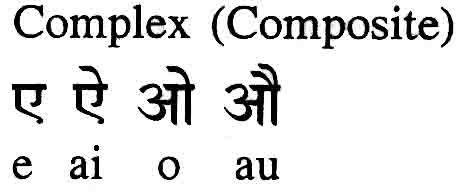梵文第三課的題目是  ,音聲之分類。第二課是描述梵文的書寫方法,這期我們要介紹所有梵文的母音。 ,音聲之分類。第二課是描述梵文的書寫方法,這期我們要介紹所有梵文的母音。
《華嚴經》上說第七地菩薩:「雖知諸佛音聲性空寂滅,不可言說,而能隨一切眾生出種種差別清淨音聲。」(註一)
第七地菩薩,在明白諸佛的音聲寂淨不可言說之同時,將佛的清淨音聲分別出不同的聲音,使其明確而真實。此種行門遠離染污,更加莊嚴佛音的清淨。
梵文 的字母,看來就像串懸在一條線上的裝飾品,而每個字所代表的音是分別明確的。同一個字母,在這個字所發的音,不會不同於在別的字上,雖然我們不是第七地菩薩,但我們也不要在分別音聲上,顯得馬虎而混淆不清。學習梵文音表可幫助我們對音聲分別清楚而明了,並且能知道此音聲是發自何處,同時字母的次序,也能幫你描述這些音聲。 的字母,看來就像串懸在一條線上的裝飾品,而每個字所代表的音是分別明確的。同一個字母,在這個字所發的音,不會不同於在別的字上,雖然我們不是第七地菩薩,但我們也不要在分別音聲上,顯得馬虎而混淆不清。學習梵文音表可幫助我們對音聲分別清楚而明了,並且能知道此音聲是發自何處,同時字母的次序,也能幫你描述這些音聲。
註一:《華嚴經》十地品第二十六,七遠行地(經卷三十七之三)
In last issue's Sanskrit Lesson #2, the list of Sanskrit Vowel Sounds on page 41 was missing the two vowels u and ū. The complete list is given below.
上期梵文課(第四十一頁) Sanskrit Vowel Sounds 表中漏列 u 和ū今補上。

Complex (Composite)

Simple Sounds 單音

|
a |
as the ‘a’ in ‘about’ |
發音如「about」中的「a」。 |

|
ā |
as the ‘a’ in ‘father’ |
發音如「father」中的「a」。 |

|
i |
as the ‘ee’ of ‘teen’ said fast |
發音如「teen」中的「ee」,但發音時短而快。 |

|
ī |
as the ‘ee’ in ‘teen’ |
發音如「teen」中的「ee」。 |

|
u |
as the ‘oo’ of ‘moon’ said fast |
發音如「moon」中的「oo」,但發音時短而快。 |

|
ū |
as the ‘oo’ in ‘moon’ |
發音如「moon」中的「oo」。 |

|

|
as ‘ri’ said fast with tongue tip curled back. |
發音「ri」音,但發音時要快而捲舌。 |

|

|
as ‘ri’, tongue tip curled slightly back. |
發「ri」音,但要捲舌發音。 |

|

|
tongue as before, say l. |
發「l」音,但要捲舌。 |

|

|
is never found, but ‘should exist’. |
此音從未被用過,但應有此音。 |
上一期梵文課介紹梵文十四個字母,現在我們以英文的發音方式,來介紹每個字的音聲。
以上的單音只發單一音聲,不像英文母音,由一音滑至另一音。梵文的長音如「ā, ī, ū」等比短音發長一倍的音,但基本上發音是相同的。
Complex Sounds 複音
很顯然地,字是由單音到複音,而且所組的字是循序的。先由發音出字口中最後部份,然後漸往前推。這也是梵文字典和索引上所用的次序。如果你知道每一個音發自口裡的哪一個部位時,不需要參考字母表,只要查查你口中發音的位置就知道了。
在母音和子音之間還有兩個字:

|

|
visarga, a kind of puff of air, only found at the end of words. |
visarga,一種氣音,如在空氣中噴送出來之音,只位於是字最後。 |

|

|
 'after-sound’ amounts to
nasalizing the vowel before it. 'after-sound’ amounts to
nasalizing the vowel before it.
|
 「後音」往往在母音之後,使其鼻音化。 「後音」往往在母音之後,使其鼻音化。
|
待續
|
|
This Sanskrit lesson discusses  ,“The Division into Sounds”. Lesson 2 described the devanāgarī script in which Sanskrit is generally written. In this issue we will introduce the Sanskrit vowels. ,“The Division into Sounds”. Lesson 2 described the devanāgarī script in which Sanskrit is generally written. In this issue we will introduce the Sanskrit vowels.
The Avatamsaka Sutra says f the Bodhisattva on the Seventh Ground:
Although he’s firmly intent upon the unutterable, the noiseless, voiceless, and naturally-till Tathagata voice, nonetheless he strives for realizations which will adorn this purity by dividing up all sound in separate parts.1
The Bodhisattva of the Seventh Bodhisattva stage realizes that the Buddha’s voice is apart from anything said or any sound. But he, while never losing sight of this, nevertheless at the same time goes ahead and discriminates the pure Buddha sound into separate sounds, and doing so he makes it concrete and actual. This practice, far from being a defilement, further ornaments the purity of the Buddha’s sound.
The letters of the the  alphabet even look like ornaments strung along a cord, and the sounds they represent are clearly distinguished. It's not a case of one letter being pronounced one way in this word and another way in that. Even if we're not Seventh Ground Bodhisattvas, we don’t want to be sloppy and confused in our sounds discriminations. Learning the Sanskrit syllabary helps us become more aware of sounds and where they come from, and the very order of the alphabet helps us describe those sounds. alphabet even look like ornaments strung along a cord, and the sounds they represent are clearly distinguished. It's not a case of one letter being pronounced one way in this word and another way in that. Even if we're not Seventh Ground Bodhisattvas, we don’t want to be sloppy and confused in our sounds discriminations. Learning the Sanskrit syllabary helps us become more aware of sounds and where they come from, and the very order of the alphabet helps us describe those sounds.
The last Sanskrit lesson introduced the fourteen Sanskrit vowels. Here they are again with their approximate pronounciation:
Note:
1. Anabhilāpya-ruta-  adhimucyate/sarva svara- adhimucyate/sarva svara- -vibhakti-visuddhy- -vibhakti-visuddhy- ca abhinirharati. ca abhinirharati.
 7A. 7A.
Simple Sounds 單音
All these are pronounced with a single, uniform pure sound, unlike English vowels which glide between one sound and another. The long vowels in Sanskrit, such as ā, ī, ū, take twice as long to say as the short ones, but they sound essentially the same.
Complex Sounds 複音

|
e |
as in ‘day’; is really a + i said together fast. |
發音如「day」中的「ay」;其實是 a 和 i 字快說而成的。 |

|
ai |
as in ‘aisle’; a + i together. |
發音如「aisle」中的「ai」;是 a 和 i 字一起。 |

|
o |
as in ‘go’; is a + u said fast. |
發音如「go」中的「o」;是 a 和 u 字快說而成的。 |

|
au |
as in ‘out’; made up of a + u. |
發音如「out」中的「ou」;由 a 和 u 字合成的。 |
Quite sensibly, the letters go from simple to complex, and within each group the letters go in order, starting with sounds produced in the back part of the mouth, and working towards the front. This is the order used in Sanskrit dictionaries and in indices to Sanskrit works. If you know the place in the mouth that each sound comes from, you don't need to consult a phonetic chart--just check your mouth.
Between the vowels and consonants are found two other letters:
to be continued
|